Mardi Gras Decoration
What Event Does Mardi Gras Celebrate?

While standing on the lively streets full of colorful floats and vibrant costumes, the atmosphere is brimming with an electrifying energy that seems to flow through the crowd.
But as we look beyond the revelry and the joyous chaos, we begin to wonder – what event does Mardi Gras actually celebrate?
The answer may surprise you, as the origins of this lively celebration are deeply rooted in history, religion, and tradition.
So, let's explore the rich tapestry of Mardi Gras and uncover the fascinating story behind this globally beloved festival.
Key Takeaways
- Mardi Gras celebrates the beginning of the Lenten season and offers a time of revelry before the fasting and penitence of Lent.
- It is a cultural expression that has evolved over centuries, blending various traditions from medieval Europe, ancient Roman pagan celebrations, and influences from French, Spanish, African, and Native American cultures.
- Mardi Gras is deeply rooted in religious customs and traditions, symbolizing reflection, amends, and spiritual growth during the 40-day period leading up to Easter Sunday.
- It is a global celebration, with different regions and cities having their own unique customs and traditions associated with Mardi Gras, with New Orleans and Brazil's Carnival being among the most famous and popular celebrations in the world.
Origins of Mardi Gras
The origins of Mardi Gras can be traced back to medieval Europe, where it evolved from ancient Roman pagan celebrations. This festival has deep cultural significance, blending elements of various traditions over centuries.
The term 'Mardi Gras,' French for 'Fat Tuesday,' reflects the practice of consuming rich, fatty foods before the fasting period of Lent. The festive traditions associated with Mardi Gras encompass a rich tapestry of customs from different cultures, including masquerade balls, colorful parades, and vibrant music. These elements have been influenced by French, Spanish, African, and Native American traditions, creating a unique and diverse celebration.
The cultural significance of Mardi Gras extends beyond its religious roots. It has become a symbol of community and revelry, a time for people to come together and celebrate life. The festive traditions of Mardi Gras serve as a means of preserving heritage and fostering a sense of unity among diverse communities.
This celebration continues to evolve, maintaining its historical roots while adapting to modern times, making it an enduring and cherished tradition for many.
Historical Significance
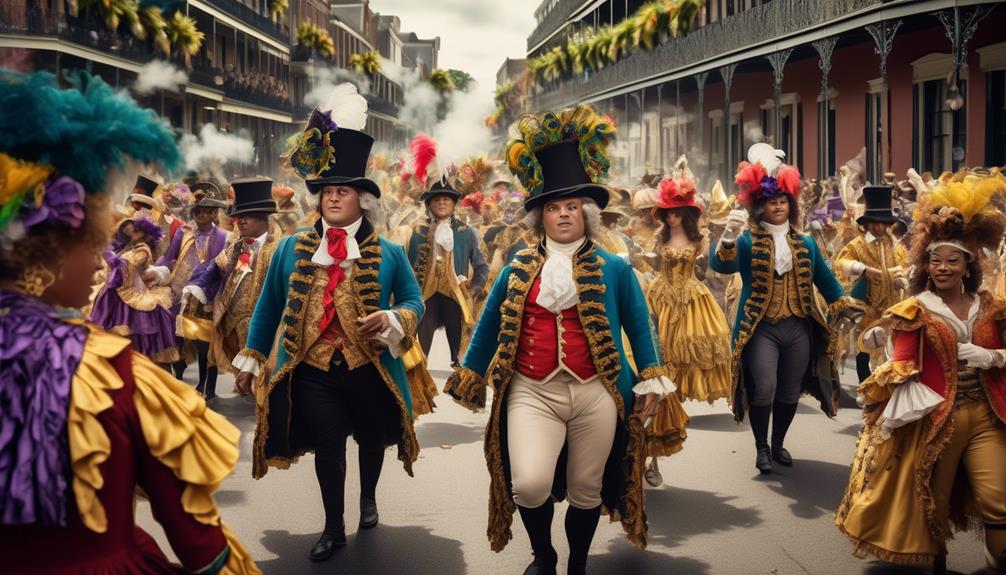
Having evolved from ancient Roman pagan celebrations and with deep cultural significance, Mardi Gras reflects a rich tapestry of customs from diverse traditions over centuries. The historical evolution of Mardi Gras can be traced back to medieval Europe, where it was incorporated into Christian liturgical practices as a period of feasting and revelry before the somber season of Lent. Over time, this celebration merged with various cultural influences brought by French and Spanish settlers in the Americas, evolving into the vibrant and dynamic festival known today.
Mardi Gras has had a profound cultural impact, becoming deeply embedded in the social fabric of communities where it's celebrated. It serves as a time for people to come together, transcending social boundaries and fostering a shared sense of identity and belonging. The festival's historical significance is also reflected in modern interpretations, where it continues to evolve as a symbol of resilience, cultural expression, and creativity.
Today, Mardi Gras stands as a testament to the enduring power of tradition and the ability of communities to adapt and thrive amidst changing times.
Religious Roots
Mardi Gras, with its origins in Christian traditions, marks the beginning of the Lenten season. This celebration, which takes place before the solemn period of Lent, has deep-rooted religious significance.
Within the context of church traditions, Mardi Gras offers a time of revelry before the observance of Lent's fasting and penitence.
Christian Origins
With its origins in the Christian religious traditions of medieval Europe, the Mardi Gras celebration has evolved into a vibrant and festive occasion with deep religious roots.
Historically, Mardi Gras, also known as Fat Tuesday, is rooted in the Christian festivals of Carnival, which are observed as a period of feasting and revelry before the somber season of Lent. This ties directly into Easter preparation, as Lent is the 40-day period of fasting and reflection leading up to Easter Sunday.
The origins of Mardi Gras can be traced back to the practices of the medieval Latin Church, where it served as a final celebration before the austerity of Lent. Over time, this celebration expanded, incorporating elements from various cultures and evolving into the colorful and lively festival known today.
Lenten Season
Rooted in the Christian festivals of Carnival, the Lenten season holds significant religious roots and marks a period of fasting and reflection leading up to Easter Sunday.
- Lenten Fasting: During this season, many Christians observe a period of fasting, giving up certain luxuries or indulgences as a form of penance and self-discipline. This tradition is symbolic of Jesus Christ's 40 days of fasting in the desert.
- Cultural Significance: The Lenten season isn't only a religious observance but also holds cultural significance in many communities around the world. It's a time for individuals to reflect on their lives, make amends, and seek spiritual growth. In some cultures, it's also a time for communal gatherings and acts of charity, further emphasizing the importance of selflessness and compassion.
Church Traditions
Embedded within the fabric of Christian faith and practice, the traditions of the church during the Lenten season have evolved to encompass a rich tapestry of rituals and observances.
Church customs and traditions play a pivotal role during this period, guiding the faithful through religious observances and practices.
The Lenten season, which culminates in the celebration of Easter, is marked by solemnity and reflection. It's a time when believers engage in acts of repentance, self-discipline, and spiritual growth, often through practices such as fasting, prayer, and almsgiving.
These religious observances are deeply rooted in the history of the Christian church, drawing from centuries-old traditions that serve to deepen the connection between individuals and their faith.
As such, the Lenten season stands as a testament to the enduring significance of church customs and traditions within the Christian community.
Shrove Tuesday
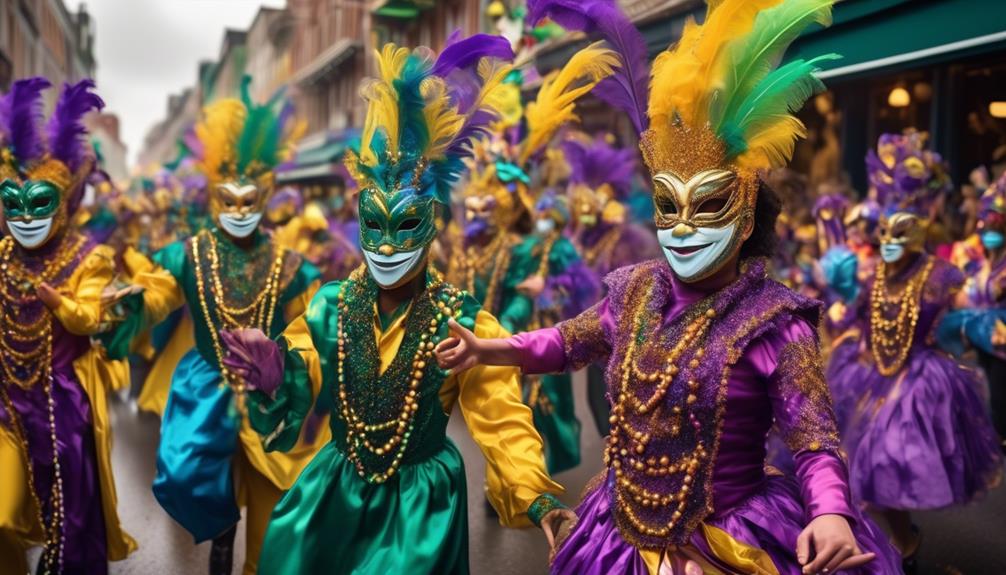
Shrove Tuesday, also known as Fat Tuesday or Pancake Day, marks the beginning of the Lenten season and is observed in many countries around the world with feasting and merriment before the solemn period of fasting and repentance. In many communities, it's a day filled with traditions and activities that bring people together in celebration.
- Pancake Races: One of the most beloved Fat Tuesday traditions is the pancake race, particularly in the United Kingdom. This lighthearted and often comical event sees participants, often dressed in aprons and scarves, racing through the streets while flipping pancakes in frying pans. The goal is to reach the finish line without dropping the pancake, and it's a delightful spectacle that has been a part of Shrove Tuesday for centuries.
- Indulgent Feasting: Another common way to mark Shrove Tuesday is by indulging in rich and decadent foods, particularly those containing sugar, fat, and eggs – ingredients that were traditionally restricted during the Lenten fast. It's a time for enjoying treats like pancakes, waffles, and pastries before the period of abstinence begins.
- Community Gatherings: Shrove Tuesday is also a time for communities to come together and enjoy each other's company before the solemnity of Lent. Whether through pancake breakfasts, street parties, or festive gatherings, the day is an opportunity for people to connect and celebrate before the austerity of the season sets in.
Lenten Season
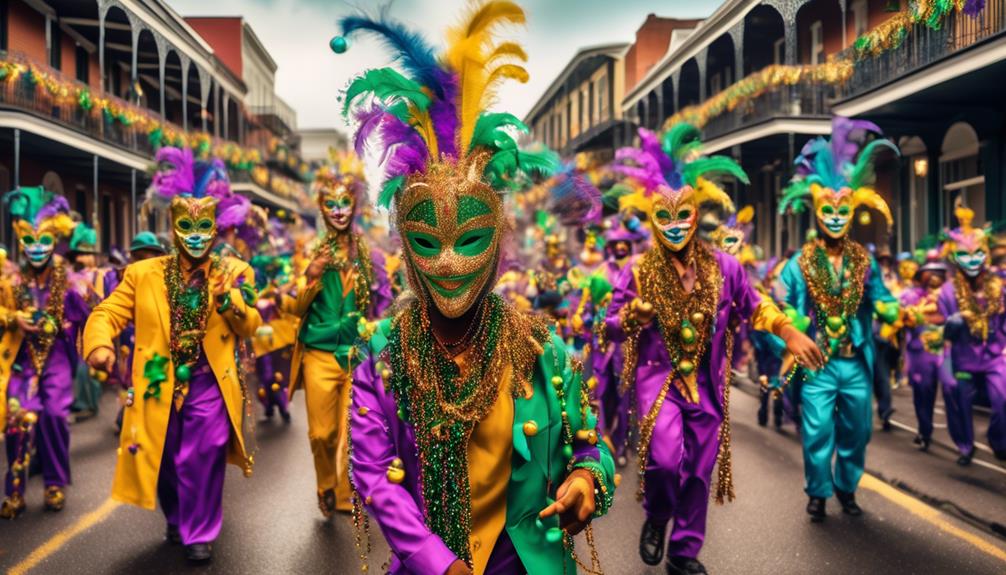
As we move from the festive indulgence of Shrove Tuesday into the Lenten season, a period of solemn reflection and spiritual discipline begins for many observant Christians around the world. The Lenten season, lasting 40 days, is a time for fasting, penance, and prayer, leading up to Easter Sunday. It symbolizes the 40 days Jesus spent fasting in the desert. Many Christians use this time to reflect on their lives, repent for their sins, and grow closer to God through prayer and sacrifice.
| Lenten Season | Fasting Traditions | Cultural Celebrations | Festive Events |
|---|---|---|---|
| A time for reflection and spiritual discipline | Fasting from certain foods or activities | Varying cultural practices, such as fish fries or vegetarian meals | Easter Sunday celebrations |
During Lent, fasting traditions vary greatly. Some abstain from meat, while others give up a favorite food or activity. This season is also marked by cultural celebrations, such as fish fries and vegetarian meals in different communities. Despite its solemn nature, the Lenten season culminates in the joyous celebration of Easter Sunday, commemorating the resurrection of Jesus Christ.
European Traditions

As we explore the European traditions of Mardi Gras, it's essential to consider the origins of masks and their historical significance.
The use of masks during Mardi Gras can be traced back to European carnivals and masquerade balls, where they were used to conceal social status and allow for uninhibited revelry.
Understanding the historical context of these traditions provides valuable insight into the cultural significance of Mardi Gras celebrations in Europe and beyond.
Origins of Masks
The historical origins of masks in European traditions can be traced back to ancient rituals and performances, serving as a means of cultural expression and social significance.
- Mask Symbolism: Masks were imbued with deep symbolic meanings, representing various aspects of human emotions, mythological creatures, and spiritual entities. They were often used in religious ceremonies, theatrical productions, and seasonal festivities to convey specific messages or evoke particular energies.
- Cultural Significance: Masks held immense cultural significance, playing a pivotal role in connecting communities with their heritage, beliefs, and collective identity. They were utilized to transmit oral traditions, pass down folklore, and uphold societal values, fostering a sense of unity and belonging among different societal groups.
- Artistic Evolution: Over time, the art of mask-making evolved, influenced by different artistic movements, technological advancements, and cross-cultural exchanges, leading to the diversification of mask designs and techniques across European regions.
Historical Significance
Evidently, masks have been integral to the fabric of European traditions, serving as potent symbols of cultural identity and societal interconnectedness. The historical significance of masks in European culture is profound, with their usage dating back to ancient civilizations like the Greeks and Romans. Masks were employed in various cultural and religious ceremonies, and they often carried symbolic meanings tied to spiritual beliefs and social hierarchies.
Over time, European traditions surrounding masks evolved, influencing art, theater, and even societal customs. The cultural impact of masks can be seen in the elaborate masquerade balls of the Renaissance era and the symbolic use of masks in rituals and festivals. These historical roots continue to inform the significance of masks in modern-day Mardi Gras celebrations, connecting contemporary festivities to their rich and culturally significant European heritage.
Arrival in America

Upon reaching the shores of America, the Mardi Gras celebration underwent a profound evolution, blending with local customs and traditions to create the vibrant festival known today.
As the celebration made its way to the new world, it encountered a melting pot of cultures, ultimately shaping its unique character. Our exploration of Mardi Gras' arrival in America unveils a fascinating tapestry of cultural influence and historical significance.
- French Influence: The French settlers brought the tradition of Mardi Gras to the southern regions of the United States, particularly Louisiana. Their customs merged with those of Spanish, African, and Native American populations, giving birth to the rich and diverse celebration we know today.
- Creole Traditions: The Creole population in Louisiana played a pivotal role in shaping the Mardi Gras festivities. Their unique blend of French, African, Spanish, and Native American cultures infused the celebration with a distinctive flair, incorporating masquerade balls, elaborate costumes, and lively music.
- American Adaptation: Over time, Mardi Gras evolved further, incorporating elements of American culture. Parades, floats, and the iconic beads became integral parts of the celebration, adding a modern American twist to this centuries-old tradition.
The arrival of Mardi Gras in America marked the beginning of its transformation into a dynamic and inclusive cultural phenomenon, embracing a myriad of influences to become the exuberant festival cherished by millions.
Evolution of Celebrations
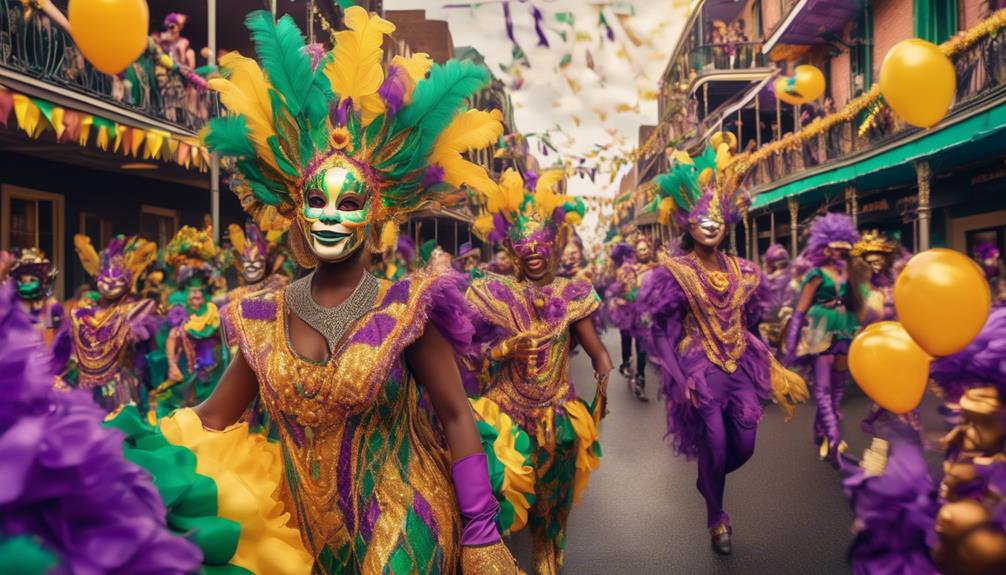
As Mardi Gras celebrations spread throughout America, they dynamically evolved to incorporate a wide array of cultural influences and traditions, shaping the festival into the vibrant and diverse spectacle it's today.
The evolution of Mardi Gras celebrations reflects the cultural significance of the communities that embraced the festival. In areas with strong French heritage, such as New Orleans, the traditional elements of masquerade balls, parades with intricate floats, and lavish feasting have been preserved and integrated with local customs.
In regions with a significant Hispanic population, Mardi Gras, known as Carnaval, features lively music, colorful costumes, and vibrant street dances. Moreover, in areas with a strong Caribbean influence, Mardi Gras celebrations include elements of Caribbean Carnival traditions, such as steel drum music and exuberant processions.
This evolution hasn't only enriched the festival with a diverse range of customs and practices but has also reinforced the sense of community and belonging among different cultural groups. Through the evolution of Mardi Gras celebrations, a tapestry of traditions has been woven, reflecting the multicultural fabric of American society and highlighting the festival's enduring cultural significance.
Symbolism of Colors
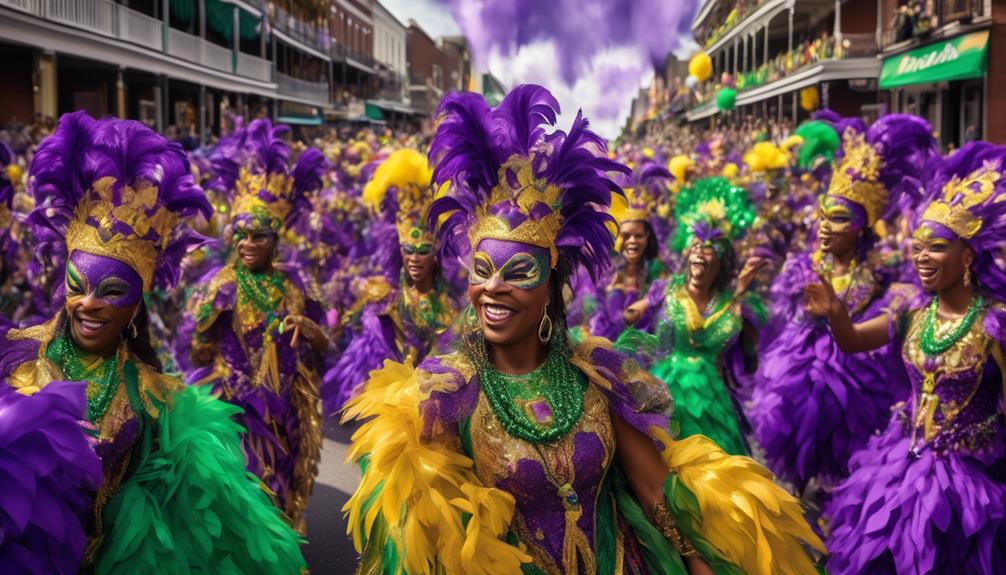
The symbolism of colors in Mardi Gras celebrations is a fascinating aspect of the tradition. We can examine the meanings behind the traditional color choices and their historical significance to gain a deeper understanding of the festival's cultural roots.
Exploring the colors of Mardi Gras sheds light on the rich symbolism and rituals that have evolved over time.
Color Meanings
What significance do different colors hold in the context of Mardi Gras celebrations? The color symbolism in Mardi Gras is deeply rooted in cultural traditions and holds significant meaning for participants. Here are the meanings associated with the colors of Mardi Gras:
- Purple: Represents justice and symbolizes the passion and resolve of the community.
- Green: Symbolizes faith and signifies the hope and renewal embraced during the celebration.
- Gold: Reflects power and represents the enduring spirit of the people and the richness of their cultural heritage.
These vibrant colors not only adorn the revelers but also convey the values and aspirations of the Mardi Gras tradition, creating a visually stunning and meaningful spectacle that resonates with the community and spectators alike.
Traditional Color Choices
Traditional color choices for Mardi Gras hold significant symbolic meaning, reflecting the values and cultural heritage of the community. The colors of purple, green, and gold have deep-rooted significance in the festive traditions of Mardi Gras.
Purple symbolizes justice, green represents faith, and gold signifies power. These colors were chosen in the late 1800s by the Rex, the King of Carnival, and have since become iconic symbols of the celebration.
Purple reflects the season of Lent and penance, green embodies the awakening of spring, and gold signifies the wealth and prosperity associated with the celebration. Each color holds a rich history and tradition, adding depth and significance to the vibrant festivities of Mardi Gras.
Understanding the symbolism behind these traditional colors enhances the appreciation of the cultural significance of this joyous event.
Traditional King Cake
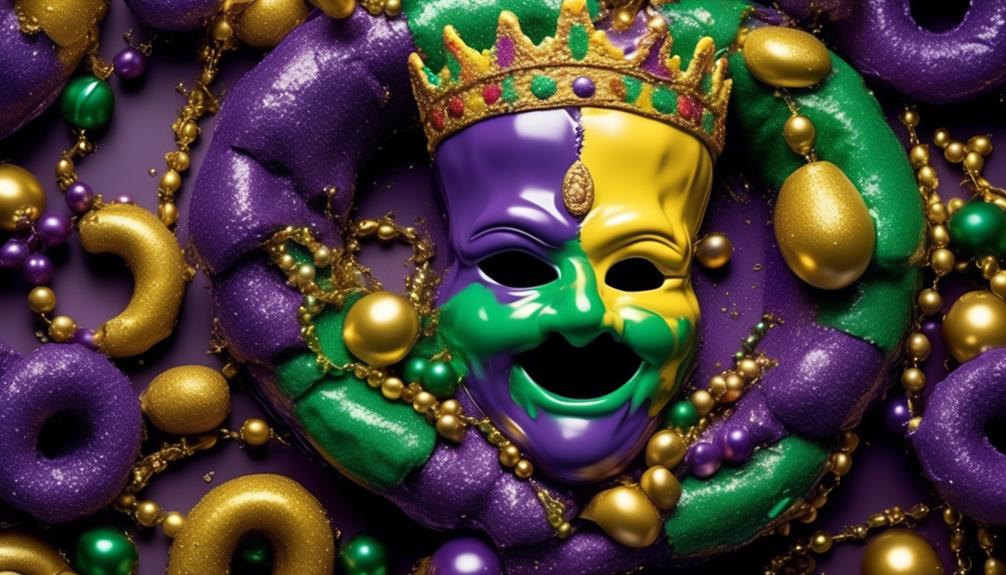
Originating in medieval France, the King Cake has become an integral part of Mardi Gras celebrations in the United States, representing the colorful and festive spirit of the holiday. This delectable pastry is rich in history and tradition, with each element holding special significance. Here are a few intriguing facets of the King Cake:
- King Cake Traditions
- The cake is often shaped in a circle to represent the unity of faith and the continuous cycle of the seasons.
- A small, hidden trinket, such as a plastic baby, is baked inside the cake, symbolizing luck and prosperity to whoever finds it in their slice.
- In earlier times, a bean or a pea was hidden in the cake, signifying the biblical story of hiding the baby Jesus from King Herod.
The modern variations of King Cake have seen an evolution in flavors and fillings, from traditional cinnamon and cream cheese to more adventurous choices like praline, apple, and even savory options. These adaptations reflect the diverse and dynamic nature of Mardi Gras celebrations, embracing new tastes while honoring the time-honored essence of the King Cake tradition.
Parades and Festivities

Amidst the vibrant streets of New Orleans, Mardi Gras parades and festivities captivate the city with an electrifying display of culture and revelry. The parades are a culmination of intricate float designs and vibrant costumes, each telling a unique story.
As we immerse ourselves in this celebration, it's fascinating to note the local traditions and cultural influences that shape these parades. The float designs are a spectacle to behold, with each one meticulously crafted to depict themes ranging from historical events to folklore. Costume contests further add to the allure, as locals and visitors alike don elaborate, colorful attire that reflects the essence of Mardi Gras.
These festivities are more than just a spectacle; they're a reflection of the city's rich history and the diverse influences that have shaped its culture. The parades and festivities not only entertain but also serve as a means of preserving and passing on traditions from one generation to the next, making Mardi Gras a truly immersive and captivating experience.
Global Mardi Gras Celebrations
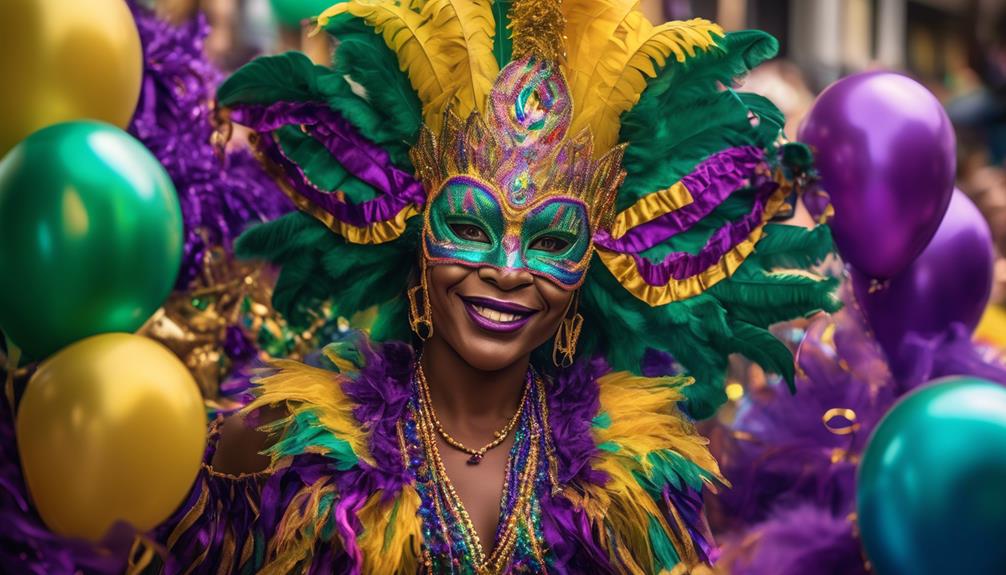
The influence of Mardi Gras celebrations in New Orleans has extended globally, with a myriad of diverse cultures embracing and incorporating its traditions into their own festive customs. From Brazil's vibrant Carnival to the colorful Carnevale in Venice, Mardi Gras has become a symbol of cultural significance and community gatherings worldwide.
Here are a few examples of how Mardi Gras is celebrated in different cultures:
- Brazil's Carnival: In Brazil, particularly in Rio de Janeiro, Carnival is a grand celebration with samba parades, street parties, and masquerade balls. The festive atmosphere and elaborate costumes reflect the local customs and traditions, creating a unique and lively Mardi Gras experience.
- Carnevale in Venice: The Carnevale in Venice, Italy, is a spectacle of opulence and elegance, with elaborate masks and costumes adorning the city's streets and squares. The celebration exudes a sense of grandeur and historical significance, emphasizing the local customs and traditions that have evolved over centuries.
- Mardi Gras in Sydney, Australia: In Sydney, Mardi Gras takes on a contemporary and inclusive tone, celebrating diversity and equality through colorful parades, performances, and community events. The festive atmosphere mirrors the city's vibrant culture and highlights the significance of unity and acceptance within the local community.
Frequently Asked Questions
What Are Some Popular Mardi Gras Costume Ideas?
For a DIY costume, consider a vibrant jester or a majestic masquerade mask.
Themed party ideas could include a 'Roaring Twenties' speakeasy or a colorful 'Carnival of Venice' soirée.
These options offer a chance to showcase creativity and embrace the festive spirit of Mardi Gras.
Guests can don elaborate headpieces, sequined attire, and theatrical makeup, adding a touch of mystique to the celebration.
How Do People in Different Countries Celebrate Mardi Gras?
In different countries, people celebrate Mardi Gras with unique cultural significance, celebratory rituals, and parade traditions.
Food customs and religious practices also vary, adding to the diversity of this festive occasion.
From vibrant parades in Brazil to elaborate masquerade balls in Venice, each culture brings its own flair to the festivities.
These diverse celebrations create a rich tapestry of traditions and customs that make Mardi Gras a truly global phenomenon.
Are There Any Famous Mardi Gras Traditions That Are No Longer Practiced?
We've found that there are indeed forgotten traditions associated with Mardi Gras, reflecting its historical significance.
Over time, some customs like the intricate masked balls or the use of flambeaux have faded away. These traditions once added unique flair to the celebrations.
Exploring these forgotten aspects can provide a deeper understanding of Mardi Gras' evolution and the cultural shifts that have shaped this iconic event.
What Is the Economic Impact of Mardi Gras on the City of New Orleans?
When it comes to the economic impact of Mardi Gras on the city of New Orleans, it's substantial. Local businesses thrive, job opportunities increase, and tourism brings in significant revenue.
The festival's vibrant atmosphere attracts a multitude of visitors, generating a substantial economic boost. This influx of tourists provides a significant financial injection into the local economy, contributing to the city's prosperity and growth.
How Has Social Media Influenced the Way People Celebrate Mardi Gras?
Social media has drastically influenced our Mardi Gras celebrations. The influence of social media on engagement and sharing has transformed the way we celebrate.
It has amplified the communal spirit, allowing us to connect with others, share experiences, and partake in the festivities even from afar.
The ability to showcase our celebrations and engage with a wider audience has truly heightened the Mardi Gras experience.
Conclusion
In conclusion, Mardi Gras is a vibrant celebration that marks the transition from indulgence to repentance.
The colorful parades, traditional king cakes, and festive atmosphere bring people together to revel in the spirit of joy and community.
As the sound of music and laughter fills the streets, Mardi Gras becomes a kaleidoscope of culture and tradition, a time to let go and embrace the spirit of togetherness before the solemnity of the Lenten season begins.
- About the Author
- Latest Posts
Introducing Ron, the home decor aficionado at ByRetreat, whose passion for creating beautiful and inviting spaces is at the heart of his work. With his deep knowledge of home decor and his innate sense of style, Ron brings a wealth of expertise and a keen eye for detail to the ByRetreat team.
Ron’s love for home decor goes beyond aesthetics; he understands that our surroundings play a significant role in our overall well-being and productivity. With this in mind, Ron is dedicated to transforming remote workspaces into havens of comfort, functionality, and beauty.
Mardi Gras Decoration
Why Are the Beads in Trees in New Orleans?

Isn’t it interesting how we’ve all seen those vibrant strands of beads draping from the trees in New Orleans, yet very few of us have paused to question their presence? As we wander through the lively streets of the city, it’s impossible not to be captivated by this enigmatic custom.
But have you ever stopped to think about the story behind these beads? What if I told you that there's more to these dangling decorations than meets the eye?
Well, get ready to uncover the fascinating tale of why the beads in trees in New Orleans hold a special place in the heart of this iconic city.
Key Takeaways
- Tree beads in New Orleans have a long history, dating back to the early 1700s, and originated as a way to mark parade-watching spots.
- Tree beads symbolize abundance, community spirit, and the rich history and enduring spirit of Mardi Gras.
- The tradition of adorning trees with beads reflects the diverse cultural influences in the city and serves as a marker for important life events.
- Tree beads in New Orleans embody the vibrant traditions, celebratory spirit, and community engagement of the city, attracting tourists and fostering a sense of connection and unity.
Origins of Tree Beads in Mardi Gras
Tracing back to the early 1700s, the tradition of hanging beads in trees during Mardi Gras originated as a way for revelers to mark their favorite parade-watching spots. This tradition reflects the joyous and communal spirit of Mardi Gras, where people come together to celebrate and create lasting memories.
The origins of this colorful practice are deeply intertwined with the festival traditions of New Orleans, where Mardi Gras has been celebrated for centuries.
In those early years, Mardi Gras was a time for people to gather and enjoy lavish feasts before the somber period of Lent. As the revelry grew, so did the desire to mark one's place along the parade routes. The custom of draping beads over tree branches allowed people to secure their spots while adding to the festive atmosphere.
Over time, this tradition became a beloved part of the Mardi Gras experience, symbolizing the excitement and sense of community that define this vibrant celebration.
Today, the sight of beads adorning the trees serves as a visual reminder of the rich history and enduring spirit of Mardi Gras. It's a tradition that continues to bring people together, creating cherished moments and strengthening the bonds of community.
Symbolism and Tradition of Tree Beads

The tradition of hanging beads in trees during Mardi Gras not only reflects the joyous and communal spirit of the celebration, but also holds deep symbolism and tradition within the vibrant culture of New Orleans.
Here's why these tree beads are more than just decorations:
- Symbolism of Abundance: The beads symbolize not only the abundance of throws during Mardi Gras but also the abundance of joy and community spirit that the festival brings to New Orleans.
- Tribute to Nature: Hanging beads in trees is a way of honoring and celebrating the natural beauty of the city, creating a stunning visual display that intertwines human celebration with the majesty of nature.
- Historical Significance: This tradition dates back decades, intertwining the modern-day revelry with the historical tapestry of New Orleans, making it a symbol of continuity and tradition.
- Community Impact: The act of hanging beads in trees is a communal effort, bringing people together to adorn the city with colorful beads, fostering a sense of togetherness and shared celebration.
The tradition of adorning trees with Mardi Gras beads is a powerful symbol of unity, abundance, and reverence for both the festival and the city's natural beauty.
Cultural Significance of Beads in Trees
Adorning trees with Mardi Gras beads embodies the rich cultural tapestry of New Orleans, highlighting the city's vibrant traditions and celebratory spirit.
The act of draping beads over tree branches carries a deep and symbolic ritual for the people of New Orleans.
These beads not only symbolize the revelry and extravagance of Mardi Gras but also serve as a historical marker of the city's resilience and unity.
The tradition of throwing beads from parade floats dates back to the 19th century when it was a gesture of goodwill and camaraderie among diverse communities.
The beads became a way to celebrate and honor the city's cultural diversity and rich heritage.
Placing these beads in trees extends this symbolism, signifying the city's ability to weather challenges and come together in celebration.
The act of placing beads in trees has evolved into a cultural tradition that reflects the historical significance of Mardi Gras and the resilience of New Orleans.
It serves as a visual reminder of the city's enduring spirit and the unity of its people, making it a poignant and cherished tradition for locals and visitors alike.
Impact on New Orleans Community

Placing beads in trees not only symbolizes the revelry and unity of New Orleans but also has a significant impact on the local community, fostering a sense of shared pride and resilience.
Here are four ways the tradition of beads in trees impacts the New Orleans community:
- Community Unity: The act of adorning trees with beads serves as a visual representation of the unity within the community, bringing people together during festivals and celebrations.
- Environmental Impact: While the beads themselves may pose an environmental challenge, the act of placing them in trees fosters a connection to nature and encourages environmental awareness within the community.
- Resilience: The tradition of placing beads in trees also reflects the resilience of the New Orleans community, as it serves as a reminder of overcoming challenges and coming together in the face of adversity.
- Local Pride: Seeing the vibrant beads adorning the trees instills a sense of local pride, reminding residents of the rich cultural heritage and traditions that make New Orleans unique.
The tradition of beads in trees not only adds to the visual charm of the city but also plays a vital role in fostering community spirit and environmental consciousness.
Exploring the Mystery of Tree Beads
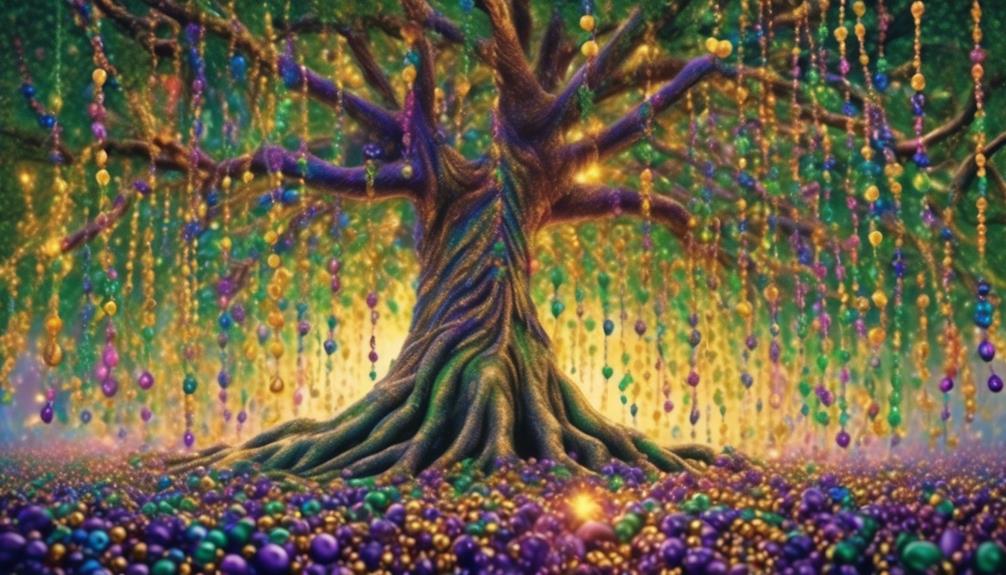
Uncovering the enigmatic origins and significance of beads nestled in the branches of New Orleans' trees has become a captivating endeavor for many curious minds. This mysterious phenomenon has woven itself deeply into the local folklore, sparking a sense of wonder and intrigue within the community. As we delve into this enigma, we find ourselves drawn into a world where traditions, history, and spirituality intersect.
The beads adorning the trees stand as silent witnesses to countless stories and traditions, inviting us to explore their hidden meanings. Local folklore suggests that the tradition of adorning trees with beads traces back to various cultural practices, including Mardi Gras celebrations, Voodoo rituals, and even as a way to mark significant life events. Each glimmering strand seems to whisper tales of jubilation, sorrow, and everything in between, creating a tapestry of experiences suspended in time.
As we embark on this journey to unravel the mystery of tree beads, we aren't merely seeking answers; we're embracing the rich tapestry of New Orleans' cultural heritage, woven intricately with threads of mystique and tradition.
Frequently Asked Questions
What Is the Environmental Impact of the Beads on the Trees in New Orleans?
The environmental impact of beads on New Orleans trees is concerning. The bead removal process is essential for tree preservation. City cleanup efforts aim to minimize this impact.
It's important to address the issue to protect our environment. We must work together to find sustainable solutions.
Are There Any Regulations or Guidelines for Hanging Beads on Trees in New Orleans?
We have seen that there are no official regulations or guidelines for hanging beads on trees in New Orleans. However, there are preservation efforts and cleanup initiatives to address the environmental impact.
Local sentiment and urban legends add to the cultural significance of this practice. While superstitions and community engagement play a role, the lack of specific regulations leaves room for interpretation and personal responsibility.
This lack of rules is as rare as finding a four-leaf clover.
How Do the Locals Feel About the Beads Being Left on the Trees Year-Round?
Local opinions on the beads in trees vary. Some see it as a cultural significance, a unique tradition that adds to the city's charm. Others worry about the impact on the environment and the community.
It's become a tourist attraction, but it's a complex issue. The beads are intertwined with the city's identity, but we're also considering the community's well-being.
Are There Any Efforts to Remove the Beads From the Trees and Clean up the City?
Efforts to clean up the city are ongoing, and the community response has been inspiring.
While some might worry about the environmental impact, the cleanup efforts are making a real difference. The city is working hard to remove the beads from the trees, and the community is coming together to keep New Orleans beautiful.
It's amazing to see everyone pitching in to restore the city's natural beauty.
Are There Any Superstitions or Urban Legends Associated With the Beads in Trees in New Orleans?
Absolutely, there are many superstitions and urban legends about the beads in trees in New Orleans. They hold deep cultural significance and are often seen as a symbol of celebration and good luck.
However, some believe that leaving the beads in trees can have a negative environmental impact. Despite the cleanup efforts, the tradition continues, adding to the city's mystique and charm.
Conclusion
In conclusion, the beads in trees in New Orleans are a mysterious and fascinating tradition that adds to the unique charm of the city.
As we've explored the origins, symbolism, and cultural significance of tree beads, it's clear that they hold a special place in the hearts of locals and visitors alike.
This tradition truly 'adds a touch of magic' to the vibrant and lively atmosphere of New Orleans during Mardi Gras.
- About the Author
- Latest Posts
Introducing Ron, the home decor aficionado at ByRetreat, whose passion for creating beautiful and inviting spaces is at the heart of his work. With his deep knowledge of home decor and his innate sense of style, Ron brings a wealth of expertise and a keen eye for detail to the ByRetreat team.
Ron’s love for home decor goes beyond aesthetics; he understands that our surroundings play a significant role in our overall well-being and productivity. With this in mind, Ron is dedicated to transforming remote workspaces into havens of comfort, functionality, and beauty.
Mardi Gras Decoration
What Is the Best Way to Celebrate Mardi Gras?

When it comes to celebrating Mardi Gras, figuring out the best way to join in on the fun is like navigating through a lively, confetti-filled maze. With numerous choices available, it can be difficult to determine where to start.
But fear not, as we explore the multitude of colorful parades, extravagant costumes, and mouthwatering Creole cuisine, we will uncover the key to unlocking an unforgettable Mardi Gras experience.
So, let's embark on this journey and uncover the secrets to celebrating Mardi Gras in the most magnificent way possible.
Key Takeaways
- Participate in Mardi Gras parades to experience the vibrant and lively atmosphere, with colorful floats and bead throwing adding to the excitement.
- Embrace the cultural significance of Mardi Gras costumes, which tell a story and symbolize history, community unity, heritage preservation, and expression of identity.
- Indulge in the tantalizing flavors of Creole cuisine, which reflects the spirit of Mardi Gras and offers a fusion of French, Spanish, African, and Native American influences.
- Immerse yourself in the live music and street performances of Mardi Gras, with jazz performances, brass bands, and street musicians creating an irresistible atmosphere and adding to the celebration.
Attend Colorful Parades
We absolutely love grabbing our beads and masks and heading down to the streets to immerse ourselves in the vibrant energy of Mardi Gras parades. The parade floats are a sight to behold, adorned with colorful decorations and blasting lively music. As the floats pass by, the air fills with excitement, and the crowd erupts with cheers and applause. It's a sensory overload in the best possible way – the rhythmic drums, the dazzling costumes, and the infectious energy of the performers all contribute to the electrifying atmosphere.
But what truly makes the parade experience unforgettable is the bead throwing. As the floats roll past, masked and costumed riders toss strings of beads into the crowd. It's a wild, joyful scramble to catch as many beads as possible, and the competition adds an extra layer of exhilaration to the festivities. The tradition of bead throwing has a long history, and it's a cherished part of Mardi Gras celebrations.
Standing shoulder to shoulder with fellow revelers, we eagerly reach out for the flying beads, laughing and cheering with each successful catch. The colorful beads become cherished souvenirs, a tangible reminder of the jubilant spirit of Mardi Gras. The energy and camaraderie of the parade experience are simply infectious, making it a highlight of our Mardi Gras celebrations every year.
Embrace Spectacular Costumes
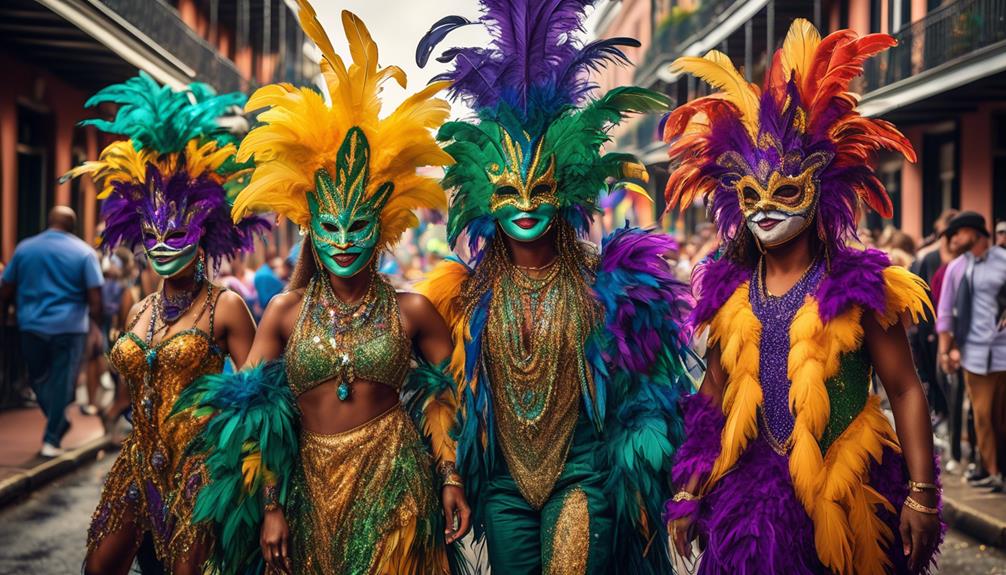
Let's talk about the incredible creativity and cultural significance behind the spectacular costumes of Mardi Gras.
From vibrant feathered masks to elaborate beaded gowns, the costumes at Mardi Gras are a sight to behold, reflecting the rich traditions and history of the celebration.
Each costume tells a story, representing different aspects of New Orleans' diverse cultural heritage and adding to the mesmerizing spectacle of the festivities.
Costume Creativity
Embracing Mardi Gras means unleashing your inner creativity through the crafting of spectacular costumes that embody the festive spirit of the celebration. Whether you're entering costume contests or simply reveling in the joy of DIY costumes, Mardi Gras is the perfect occasion to let your imagination run wild. To give you some inspiration, here are a few costume ideas that are sure to make you the star of the parade:
| Costume Idea | Description | Accessories Needed |
|---|---|---|
| Masquerade Ball Attire | Elegant and mysterious masks and gowns | Feathers, sparkles, lace |
| Jazz Musician Ensemble | Snazzy suits and jazzy accessories | Fedora, trumpet, bowtie |
| Enchanting Carnival Mask | Intricately designed masks and capes | Glitter, ribbons, jewels |
Get ready to turn heads and make a grand entrance at Mardi Gras with these fabulous costume concepts!
Cultural Significance
With cultural roots deeply intertwined in the fabric of the celebration, Mardi Gras costumes embody the rich heritage and vibrant spirit of the festivities. Each costume reflects centuries-old cultural traditions and historical significance. Embracing spectacular costumes during Mardi Gras is more than just a visual spectacle; it's a way of honoring the diverse cultural influences that have shaped this iconic event. The significance of these costumes goes beyond mere adornment; they're a living testament to the resilience and creativity of the communities that have upheld these customs for generations.
- Symbolism: Costumes often symbolize aspects of history, mythology, or local folklore.
- Community Unity: The act of creating and wearing costumes fosters a sense of community and shared identity.
- Heritage Preservation: Through costumes, cultural traditions are preserved and passed down to future generations.
- Expression of Identity: Costumes provide a platform for individuals to express their unique cultural backgrounds.
Indulge in Creole Cuisine
Indulging in Creole cuisine offers a tantalizing experience of rich flavors and cultural fusion that will leave your taste buds longing for more. Creole cooking is a vibrant tapestry woven from the diverse culinary traditions of New Orleans, blending French, Spanish, African, and Native American influences into a symphony of flavors. From savory étouffée to spicy jambalaya, Creole cuisine is a celebration of bold and complex tastes that reflect the spirit of Mardi Gras itself.
One can't help but be captivated by the culinary delights that await during Mardi Gras. The aroma of simmering gumbo and the sizzle of blackened catfish tantalize the senses, beckoning us to partake in a feast that embodies the festive spirit of the occasion. The bold spices, fresh seafood, and hearty stews are a testament to the rich tapestry of cultures that have shaped Creole cuisine over the centuries.
Immerse in Live Music
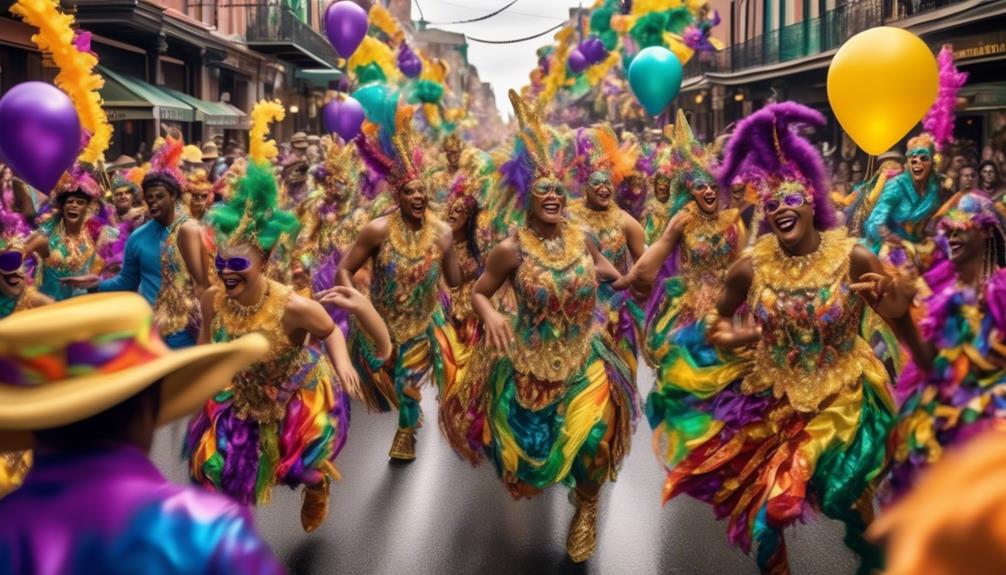
Let's talk about immersing ourselves in the vibrant world of live music during Mardi Gras!
From the soulful melodies of live jazz performances to the infectious rhythms of brass bands that make you want to dance, the streets come alive with the sounds of celebration.
Experience the energy of street musicians adding their own flair to the festivities, creating an atmosphere that's impossible to resist.
Live Jazz Performances
Immerse yourself in the vibrant rhythms and soulful melodies of live jazz performances, where the music comes alive and sweeps you into a world of pure musical magic.
- Intimate Venues: Seek out cozy jazz clubs or intimate lounges for an up-close and personal experience with the music.
- Diverse Lineups: Look for venues that offer a diverse range of jazz styles, from classic standards to cutting-edge jazz fusion.
- Engage with the Artists: Attend performances where artists engage with the audience, sharing insights into their creative process and the art of jazz improvisation.
- Late Night Sessions: Experience the authentic New Orleans vibe by finding late-night jazz sessions that keep the music going into the early hours.
Live jazz performances offer an unparalleled opportunity to connect with the heart and soul of Mardi Gras through the universal language of music.
Dance to Brass Bands
As the infectious rhythms of brass bands fill the air, we find ourselves irresistibly drawn to the dance floor, where our spirits are lifted by the exuberant melodies and pulsating beats. The pulsating energy of the brass bands at Mardi Gras is truly captivating. To fully immerse in this experience, consider participating in dance competitions to showcase your moves and feel the rhythm deep within your soul. Additionally, join brass band workshops to learn about the rich history and unique techniques of this musical tradition. Here's a glimpse of what you can expect:
| Time | Activity | Location |
|---|---|---|
| 10:00 AM | Dance Competition | Main Stage |
| 2:00 PM | Brass Band Workshop | Cultural Center |
| 6:00 PM | Dance-off Finals | Parade Route |
| 9:00 PM | Live Brass Band Performance | Town Square |
The Mardi Gras celebration offers an incredible opportunity to dance to brass bands and fully embrace the joy of live music.
Experience Street Music
The infectious rhythms of brass bands may fade, but our thirst for live music continues to pulse through the streets of Mardi Gras, drawing us deeper into the immersive experience of street performances.
As we sway to the melodic beats, street dancing becomes an irresistible urge, compelling us to move in sync with the vibrant tunes.
To fully immerse ourselves in the music, we seek out hidden alleyways where local musicians gather, creating impromptu concerts that captivate our senses.
The soulful melodies of jazz and blues spill out onto the cobblestone streets, enveloping us in a sonic embrace that transcends language and connects us on a primal level.
With every step, we become part of the living, breathing symphony that defines the spirit of Mardi Gras, celebrating music immersion in its purest form.
- Discovering hidden alleyway concerts
- Engaging in spontaneous street dance
- Savoring the soulful melodies of jazz and blues
- Becoming part of the living, breathing symphony
Join Masquerade Balls
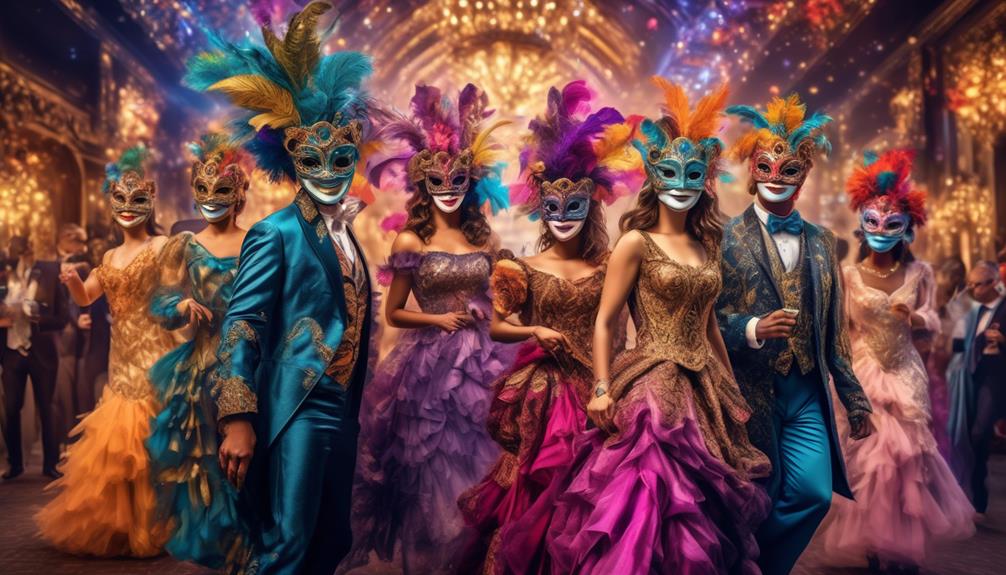
Donning elaborate masks and elegant attire, revelers eagerly anticipate the thrilling experience of joining masquerade balls during Mardi Gras. These enchanting events offer a perfect blend of mystery, elegance, and festivity that captures the true spirit of the carnival season. The allure of masquerade balls lies in their air of secrecy and sophistication, as participants immerse themselves in the enchanting atmosphere of masked soirees.
One of the most exciting aspects of masquerade balls is the opportunity to showcase creativity through elaborate costumes. Costume contests add an element of friendly competition, inspiring attendees to don their most extravagant and imaginative ensembles. The thrill of being surrounded by others adorned in lavish attire and mysterious masks creates an electrifying energy that's truly unforgettable.
Masquerade balls provide the ideal setting for an evening of enchantment and revelry. The combination of ornate masks, elegant attire, and a sense of anonymity fosters an atmosphere of excitement and anticipation. The allure of these events lies in the air of mystery and the opportunity to experience the magic of Mardi Gras in a truly captivating way.
Explore French Quarter

Exploring the French Quarter is like stepping into a vibrant and historic world filled with music, culture, and culinary delights after a night of enchanting masquerade balls.
The architecture of the French Quarter is a sight to behold. The ornate iron-lace balconies, colorful Creole cottages, and historic buildings transport you to another time, making every street corner a photo opportunity.
As we wander through the cobblestone streets, the tantalizing aroma of local cuisine wafts through the air, beckoning us to indulge in culinary delights. From beignets and po'boys to gumbo and jambalaya, the French Quarter offers an array of mouthwatering dishes that are a true reflection of the city's rich culinary heritage.
The soul-stirring melodies of jazz and blues spill out from every corner, inviting us to sway to the rhythm of the city. The French Quarter is a treasure trove of hidden courtyards, charming shops, and lively street performances, ensuring that every step is infused with magic and wonder.
Sample King Cake

Our first encounter with the King Cake was a delightful surprise, as its vibrant colors and sweet aroma beckoned us to partake in this traditional Mardi Gras treat. The traditional recipe, with its rich history dating back to medieval Europe, consists of a sweet, yeasted dough twisted into a ring and adorned with purple, green, and gold icing to represent justice, faith, and power. A small plastic baby, symbolizing luck and prosperity, is hidden inside the cake. Whoever finds the baby is responsible for hosting the next Mardi Gras celebration.
In recent years, modern variations of the King Cake have emerged, featuring innovative fillings such as cream cheese, praline, and even savory options like boudin. Some adventurous bakers have experimented with different shapes and designs, adding a contemporary twist to this age-old delicacy.
Whether you opt for the traditional recipe or indulge in one of the modern variations, the King Cake remains an essential part of Mardi Gras tradition. Its festive colors and delectable flavors symbolize the joy and revelry of this vibrant celebration. So, when Mardi Gras approaches, don't miss the opportunity to savor a slice of this iconic dessert.
Engage in Street Performances

As we relish the festive flavors of the King Cake, our senses are drawn to the lively rhythm of street performances, where the spirit of Mardi Gras comes alive through music, dance, and theatrical displays.
Engaging in street performances during Mardi Gras is an immersive experience that allows us to connect with the vibrant street performance culture and become an active part of the celebrations. Here's why we can't resist the allure of street performances:
- Immersive Atmosphere: Street performances create an immersive and interactive atmosphere, drawing us into the heart of the Mardi Gras festivities.
- Celebrating Diversity: These performances showcase the diversity of talents within the community, celebrating different art forms and cultural expressions.
- Engagement and Participation: Attending street performances encourages active community engagement, fostering a sense of togetherness and shared celebration.
- Spontaneous Delights: The spontaneity of street performances adds an element of surprise and delight to the Mardi Gras experience, keeping the celebration dynamic and lively.
As we join in the festivities, the energy and creativity of street performances truly enhance our Mardi Gras celebration, making it an unforgettable experience of community engagement and artistic expression.
Experience Mardi Gras History
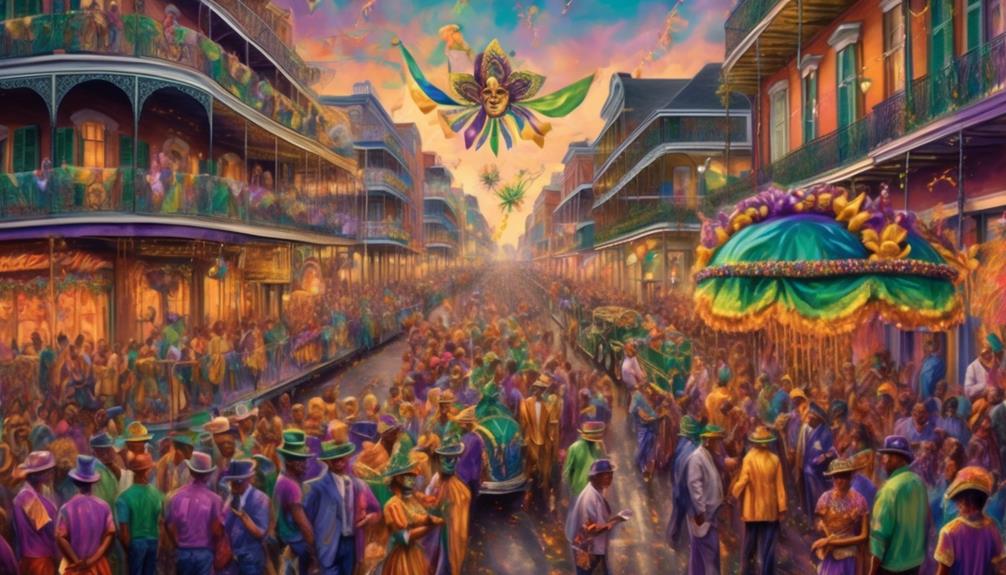
Seldom do we have the opportunity to delve into the rich tapestry of Mardi Gras history, uncovering the fascinating traditions and cultural significance that have shaped this vibrant celebration.
Mardi Gras, with its roots in medieval Europe, has evolved over centuries, blending French, Spanish, and African influences to create a unique cultural phenomenon. The traditions of Mardi Gras, such as the colorful parades, elaborate masks, and joyous music, all have deep historical significance. The tradition of throwing beads and trinkets from parade floats, for example, dates back to the 19th century, symbolizing good luck and prosperity for the recipients. Understanding the historical significance of these traditions adds a deeper layer of appreciation for the festivities.
Exploring Mardi Gras history can offer a profound sense of connection to the past and an understanding of the cultural fusion that characterizes this celebration. The diverse influences that have shaped Mardi Gras traditions have made it a truly inclusive and joyous event, bringing people together in revelry and celebration.
Participate in Mask Making

Let's get creative and make our own Mardi Gras masks!
We'll explore different mask making techniques and decoration ideas to bring our designs to life.
Get ready to unleash your imagination and craft a unique mask that captures the spirit of Mardi Gras!
Mask Making Techniques
Exploring various mask making techniques has been an engaging and creative experience for our community. We've discovered some exciting ways to bring our masks to life. Here are a few techniques that have really captured our imagination:
- Mask Painting Techniques: From bold and vibrant colors to delicate and intricate designs, we've experimented with various painting techniques to add personality to our masks.
- Embellishment Ideas: Incorporating feathers, sequins, and beads has allowed us to add texture and flair to our masks, making them truly stand out.
- Molding and Sculpting: Using materials like papier-mâché and clay, we've crafted unique three-dimensional designs, adding depth and character to our masks.
- Mixed Media Fusion: Combining different materials such as fabric, paper, and found objects has given our masks a whimsical and eclectic touch.
Mask Decoration Ideas
As we gather to celebrate Mardi Gras, let's delve into creative mask decoration ideas that will elevate our festive spirit and add a touch of individuality to our masks.
Mask painting is a fantastic way to customize your mask. Consider using vibrant colors, intricate designs, or even adding glitter for a sparkling effect.
Additionally, incorporating DIY crafts into mask decoration can be an enjoyable and personal activity. You could use feathers, beads, or sequins to embellish your mask and make it truly unique.
Another idea is to use fabric or lace to create a stunning and elegant look. By embracing these mask decoration ideas, we can infuse our Mardi Gras celebration with creativity and flair, ensuring that our masks aren't only festive but also reflect our own personalities.
Revel in Carnival Rides

We eagerly anticipate the thrill of carnival rides as we celebrate Mardi Gras, adding an exciting element to our festive revelry. The carnival rides at Mardi Gras offer an exhilarating experience that adds a dash of adrenaline to our celebration.
Here are some ways we can revel in the excitement of carnival rides:
- Try the classics: Take a whirl on the timeless favorites like the Ferris wheel or the merry-go-round. These classic rides are perfect for all ages and add a touch of nostalgia to the festivities.
- Challenge your bravery: Test your courage by hopping on heart-pounding rides like the roller coasters or the drop towers. The rush of wind in your face and the screams of excitement will make for an unforgettable Mardi Gras experience.
- Enjoy the family-friendly options: Explore the family-friendly rides designed for little ones, ensuring that everyone can partake in the joy of the carnival.
- Discover unique attractions: Seek out unique and innovative rides that offer a fresh twist on traditional carnival experiences. This is a great way to spice up your Mardi Gras celebration and create lasting memories.
With carnival games and thrilling rides, Mardi Gras becomes a whirlwind of fun and excitement for all who attend.
Enjoy Fireworks Display
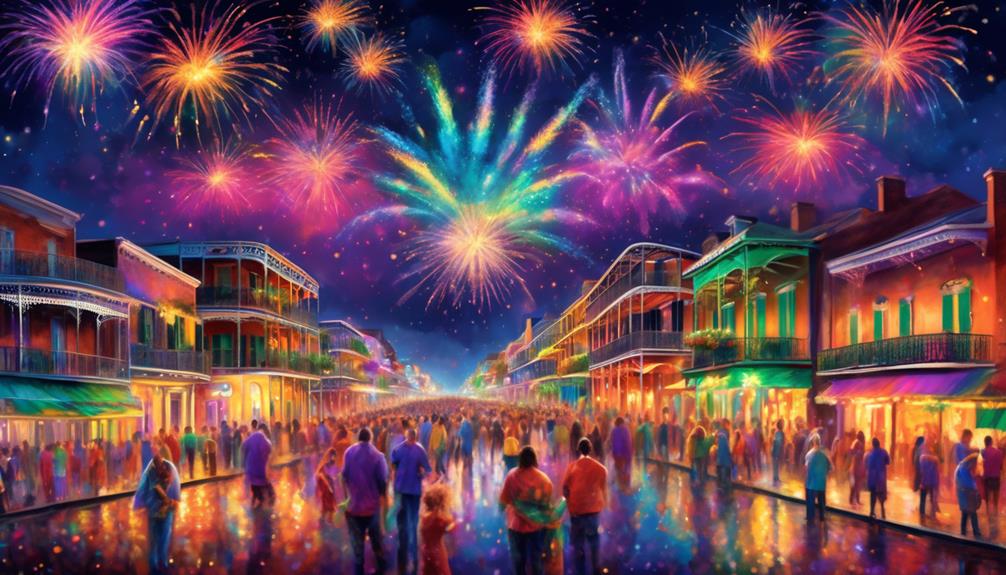
After thrilling rides and festive revelry, our attention turns to the mesmerizing spectacle of the fireworks display, igniting the night sky with bursts of color and light. The fireworks extravaganza at Mardi Gras is a sight to behold, and there's no better way to experience it than with waterfront viewing. As the sun sets and the anticipation builds, finding the perfect spot along the water's edge becomes part of the excitement.
Families and friends gather, eagerly awaiting the fireworks show, creating an atmosphere of joy and togetherness. The fireworks display isn't just a visual feast; it's also a culmination of the day's family-friendly activities. As the first sparks shoot into the sky, there's a collective gasp of awe and wonder. Each explosion brings a new wave of cheers and applause, creating a symphony of delight. The vibrant colors reflect on the water, adding an extra layer of magic to the experience.
As the grand finale lights up the night, it's impossible not to feel a sense of unity and joy. The fireworks display is a beautiful reminder of the shared moments and memories that make Mardi Gras such a special celebration.
Frequently Asked Questions
Where Are the Best Spots to View the Mardi Gras Parades?
When it comes to the best spots to view the Mardi Gras parades, we've got the inside scoop. The parade routes offer some prime spectator spots, perfect for soaking up the energy and excitement of the festivities.
If you're looking for a more elevated experience, balcony views overlooking the street parties are a great option.
Whether you're down in the action or above it all, Mardi Gras offers something for everyone!
Are There Any Family-Friendly Events and Activities During Mardi Gras?
We found plenty of family-friendly activities during Mardi Gras. Kid-friendly parades, children's events, and family-friendly attractions ensure everyone has a blast. From colorful parades to interactive exhibits, there's something for everyone.
Family-friendly entertainment and festivities keep the fun going all day long. Whether it's enjoying live music or indulging in delicious treats, Mardi Gras offers something for every member of the family to enjoy.
What Are Some Lesser-Known Traditions or Customs Associated With Mardi Gras?
So, when it comes to Mardi Gras, there are some lesser-known traditions and customs that add to the excitement.
One of the unique aspects is the intricate Mardi Gras costumes, which are a big part of the celebrations.
Additionally, traditional foods like king cake and beignets are a must during this festive time.
These customs add a special touch to the Mardi Gras experience, making it even more lively and enjoyable.
How Can I Participate in the Local Community During Mardi Gras?
Getting involved in the local community during Mardi Gras is a fantastic way to soak up the festive atmosphere and give back. There are various volunteering opportunities, from helping with parades to lending a hand at community events. It's a chance to connect with locals, contribute to the vibrant celebrations, and make lasting memories.
Whether you're serving up jambalaya or assisting with decorations, participating in the community during Mardi Gras is an enriching experience for everyone involved.
Are There Any Special Events or Activities for Those Looking for a More Relaxed Mardi Gras Experience?
For those seeking a more relaxed Mardi Gras, there are plenty of options for quiet celebrations. From leisurely strolls through the historic neighborhoods to enjoying live jazz in serene venues, there are many relaxing activities to choose from.
You can also partake in intimate gatherings with close friends, savoring delicious Cajun cuisine and soaking in the festive ambiance.
Whatever your preference, there's a tranquil way to enjoy the Mardi Gras spirit.
Conclusion
As we wrap up our Mardi Gras celebration, let's remember that the best way to celebrate is like dancing in a sea of vibrant colors, feeling the rhythm of the city pulsing through our veins.
Let's keep the spirit of Mardi Gras alive in our hearts until we meet again next year. Until then, let the memories of this year's festivities be like a warm embrace on a cold winter's night.
Let the joy of Mardi Gras stay with us always.
- About the Author
- Latest Posts
Introducing Ron, the home decor aficionado at ByRetreat, whose passion for creating beautiful and inviting spaces is at the heart of his work. With his deep knowledge of home decor and his innate sense of style, Ron brings a wealth of expertise and a keen eye for detail to the ByRetreat team.
Ron’s love for home decor goes beyond aesthetics; he understands that our surroundings play a significant role in our overall well-being and productivity. With this in mind, Ron is dedicated to transforming remote workspaces into havens of comfort, functionality, and beauty.
Mardi Gras Decoration
What Is the Meaning of the Angel Tree-Topper?
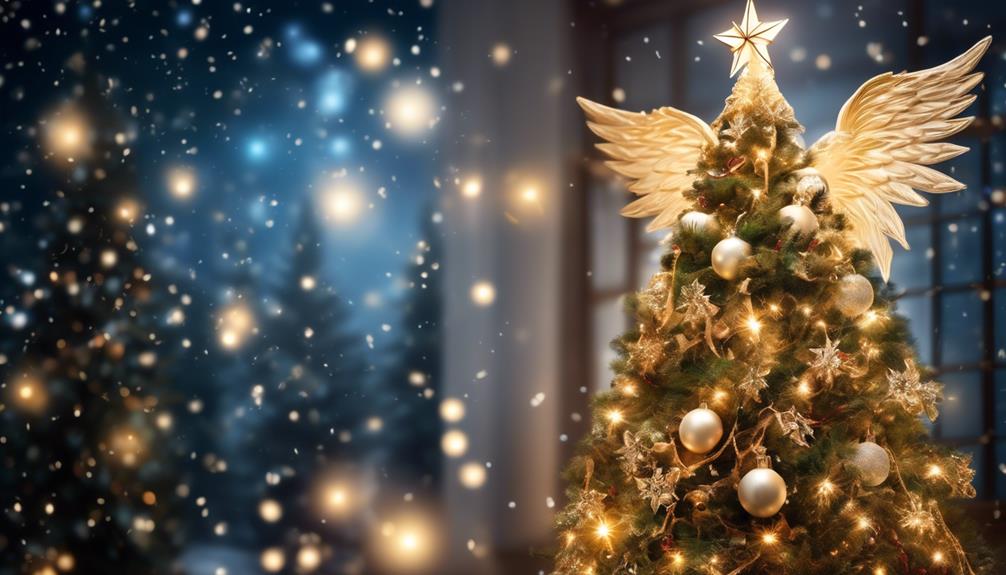
Have you ever stopped to ponder the deeper meaning behind the angel tree topper as it stands as a symbol of grace and guidance when we gather around our festive trees each year?
The tradition of placing an angel atop the Christmas tree dates back centuries and holds a rich history intertwined with angelic symbolism, religious connotations, and cultural traditions.
But what does the angel tree topper truly represent, and how has its meaning evolved over time?
Join us as we explore the layers of meaning behind this iconic holiday adornment, from its historical origins to its modern interpretations, and uncover the profound significance it holds in our holiday celebrations.
Key Takeaways
- The angel tree-topper originated in medieval Germany and is deeply embedded in religious symbolism and cultural traditions.
- It represents celestial beings who act as intermediaries between heaven and earth and announces the arrival of hope, salvation, and divine love.
- The angel tree-topper symbolizes peace, goodwill, and joy, and can also represent a spiritual guardian or a loved one who has passed.
- The modern interpretation of the angel tree-topper reflects diversity and inclusivity, showcasing contemporary artistic designs and customization to individual beliefs and values.
Historical Origins
The historical origins of the angel tree-topper can be traced back to medieval Germany, where it was believed that placing an angel or star atop the Christmas tree symbolized the angel Gabriel or the Star of Bethlehem. These angelic imagery and artistic representations were deeply embedded in religious symbolism and cultural traditions.
The angel tree-topper served as a reminder of the biblical accounts of the birth of Jesus Christ. It symbolized the angelic proclamation of peace and goodwill, as well as the guiding light of the Star of Bethlehem. The act of placing an angel at the pinnacle of the tree signified the presence of heavenly messengers in the midst of the festive celebrations.
In medieval times, the angel tree-topper was often crafted with intricate details, reflecting the reverence and importance attached to the symbol. The artistic representations varied, but they consistently portrayed the angel in a position of grace and elegance.
This tradition of adorning the tree with an angelic figure has been cherished for centuries, serving as a poignant link to our rich cultural and religious heritage.
Angelic Symbolism

As we explore the angelic symbolism associated with the tree-topper, we find a rich tapestry of religious and cultural significance woven into this cherished tradition. The angelic imagery of the tree-topper holds deep spiritual meaning for many, serving as a divine representation and a reminder of heavenly blessings during the holiday season.
Here are some key points to consider:
- Spiritual Guardians: The angel atop the tree is often seen as a spiritual guardian, watching over the home and its inhabitants, symbolizing protection, guidance, and love.
- *Personal Connection*: Many families view the angel as a representation of a loved one who's passed, creating a sense of comfort and connection during the holidays.
- Heavenly Messengers: In religious contexts, angels are depicted as messengers of God, bringing good tidings and spreading joy. The tree-topper serves as a reminder of the joy and hope associated with the holiday season.
- *Symbol of Peace*: The presence of an angelic figure on top of the tree can also symbolize peace and goodwill, reflecting the essence of the holiday spirit.
- Cultural Traditions: Across various cultures, angels hold different meanings, often representing purity, beauty, and grace. The tree-topper, with its angelic form, reflects these cultural interpretations, adding depth and diversity to its symbolism.
- *Artistic Expression*: The design of the angel tree-topper often reflects cultural and artistic influences, showcasing the diversity of interpretations of angelic imagery.
Understanding the angelic symbolism of the tree-topper adds a layer of depth and significance to this beloved holiday tradition.
Religious Significance
Exploring the religious significance of the angel tree-topper reveals its profound role in symbolizing divine presence and conveying messages of hope and joy during the holiday season. The angel, as a religious symbol, represents spiritual significance and embodies the essence of God's messengers as portrayed in the Bible.
In Christianity, angels are viewed as celestial beings who act as intermediaries between heaven and earth, delivering God's will and protection to humanity. As such, the angel tree-topper serves as a visual reminder of the spiritual realm and the benevolent presence of divine forces in our lives.
The religious symbolism of the angel tree-topper extends beyond its decorative function. It serves as a symbolic representation of the angelic hosts who heralded the birth of Jesus Christ, bringing tidings of great joy and proclaiming peace on earth. This connection to the nativity story underscores the angel's role in announcing the arrival of hope, salvation, and divine love to the world.
Thus, the angel tree-topper becomes a poignant expression of faith and a beacon of light during the holiday season, evoking a sense of reverence and awe for the miraculous events celebrated in religious traditions.
Cultural Traditions

During the holiday season, my family and I incorporate cultural traditions that add a rich tapestry of customs and rituals to our celebrations. These cultural practices have been passed down through generations and hold deep meaning for us. Here are a few of the holiday customs that hold special significance in our family:
- Traditional Foods: We prepare and enjoy traditional dishes that have been a part of our cultural heritage for centuries. These recipes have been lovingly preserved and are an essential part of our holiday gatherings.
- Festive Decorations: Our home is adorned with decorations that reflect our cultural heritage. From colorful ornaments to handcrafted items, each piece holds a story and connects us to our roots.
- Special Ceremonies: We participate in special ceremonies and rituals that have been practiced in our culture for centuries. These ceremonies bring a sense of continuity and connection to our ancestors.
In embracing these cultural traditions, we find joy and comfort in celebrating the holidays in a way that's deeply meaningful to our family. These customs not only connect us to our heritage but also bring us closer together as we honor our shared past and create new memories for the future.
Evolution Over Time
Let's explore how the symbolism of the angel tree-topper has evolved over time.
From ancient cultural variations to modern interpretations, the meaning behind this decorative tradition has undergone significant changes.
Understanding this evolution can provide insight into the significance of angel tree-toppers in different societies and eras.
Symbolism of Angel
Over time, the symbolism of the angel has evolved to encompass a range of meanings and interpretations.
- The concept of angelic guidance has become intertwined with the angel tree-topper, symbolizing protection, guidance, and blessings for the household.
- Many families view the angel as a representation of a guardian watching over their home, bringing comfort and reassurance during the holiday season.
- The angel's significance in holiday traditions has deepened, signifying peace, hope, and the spiritual essence of Christmas.
- As a central figure in the Nativity story, the angel tree-topper serves as a reminder of the divine message of joy and goodwill.
- Modern interpretations also embrace the angel as a symbol of inclusivity and diversity, reflecting the evolving values and beliefs of communities.
The evolving symbolism of the angel tree-topper continues to resonate deeply within our holiday traditions, offering comfort and inspiration.
Cultural Variations
The evolving symbolism of the angel tree-topper has been influenced by cultural variations over time, reflecting changing beliefs and traditions surrounding the holiday season. Cultural customs and holiday traditions have played a significant role in shaping the representation of angels on top of Christmas trees.
In some cultures, angels are seen as guardians and messengers of peace, embodying the spirit of the season. Over time, the angel tree-topper has evolved to represent diverse cultural beliefs, incorporating elements from different traditions and customs. As a result, the symbolism of the angel tree-topper has become a beautiful amalgamation of various cultural influences, reflecting the global nature of holiday celebrations.
This evolution highlights the significance of embracing diversity and inclusivity, as holiday traditions continue to adapt and evolve in today's interconnected world.
Modern Interpretations
Reflecting the changing beliefs and traditions surrounding the holiday season, the modern interpretations of the angel tree-topper have undergone significant evolution over time. In contemporary society, the angel tree-topper holds diverse meanings, reflecting the richness of cultural and personal interpretations. Here's what the modern interpretations encompass:
- Diversity of Representation: Today, angel tree-toppers come in various ethnicities and forms, representing the diversity of humanity.
- Contemporary Symbolism: Modern interpretations often view the angel as a symbol of hope, peace, and protection, carrying a message of positivity and goodwill.
- Personal Expression: Many individuals now use angel tree-toppers to express their unique spirituality, personal beliefs, and individuality, making it a meaningful addition to their holiday decor.
These modern interpretations demonstrate the evolving significance of the angel tree-topper in contemporary culture.
Artistic Representations

When it comes to artistic representations of the angel tree-topper, we can see a rich tapestry of symbolism woven into various art forms. These representations often hold deep cultural significance and reflect the values and beliefs of different communities.
Exploring the artistic interpretations of the angel tree-topper allows us to understand the diverse ways in which this symbol is embraced and expressed.
Symbolism in Art
In art, symbolic representations often convey deeper meanings through visual imagery, evoking emotions and ideas that transcend the literal depiction. When exploring symbolism in literature, we find that it often serves as a powerful tool for conveying complex ideas and emotions through artistic expression.
This can be seen in various forms, such as:
- Allegory: Artists use symbolic imagery to represent abstract ideas or moral qualities, inviting viewers to interpret the deeper meaning behind the artwork.
- Metaphor: Visual metaphors in art allow for the representation of one concept in terms of another, creating thought-provoking connections and layers of interpretation.
- Iconography: Through the use of symbols and iconic imagery, artists communicate cultural or religious meanings, enriching the artwork with historical and traditional significance.
Cultural Significance
Artistic representations carry significant cultural meaning, reflecting the values, beliefs, and traditions of diverse societies.
The angel tree-topper holds a deep cultural significance, often representing spiritual and religious beliefs. In many cultures, angels are seen as messengers of God, symbolizing protection, guidance, and hope.
The act of placing an angel as a tree-topper during the holiday season is rooted in cultural beliefs and traditional practices that have been passed down through generations. It serves as a visual reminder of the spiritual significance of the season and the presence of divine love and protection.
The portrayal of angels in various artistic forms, including tree-toppers, reflects the enduring influence of these cultural beliefs and traditional practices in shaping the way communities celebrate and express their faith.
Angel Tree Topper Styles
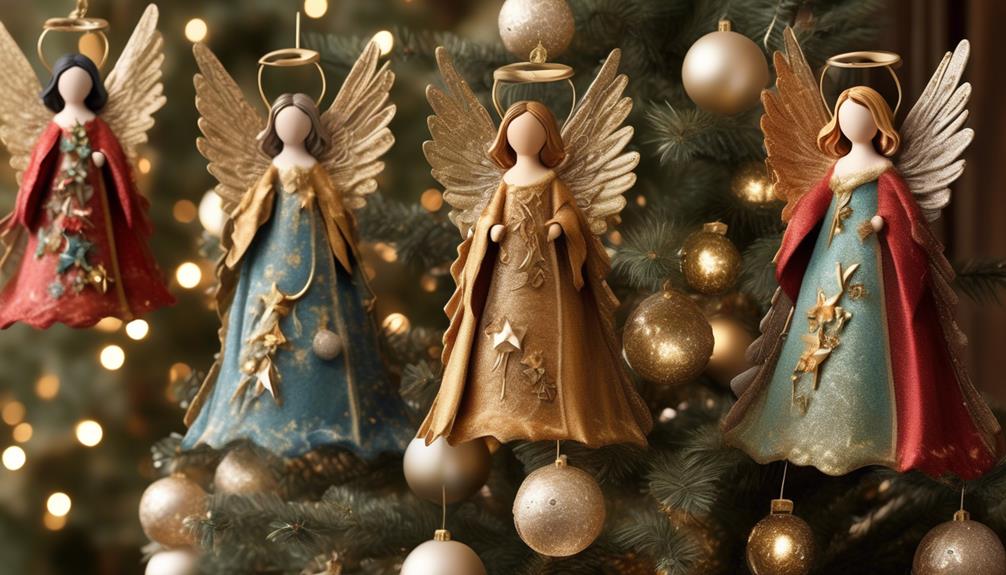
One popular style for angel tree toppers is the elegant and classic design with flowing robes and wings. This angelic design adds a touch of grace and beauty to the top of the Christmas tree.
When choosing an angel tree topper, consider the following styles:
- Traditional Angels:
- These toppers feature classic angelic designs with intricate details on their wings and robes, often carrying candles or musical instruments.
- Modern Minimalist Angels:
- For a sleek and contemporary look, opt for a minimalist angel with clean lines and simple, understated wings and attire.
- Victorian-Inspired Angels:
- These toppers evoke a sense of nostalgia with vintage-inspired designs, delicate lace details, and ornate decorative elements.
As we explore the various styles of angel tree toppers, it's essential to consider how each one can reflect our personal style and add a meaningful touch to our holiday decor. Whether it's a traditional, modern, or vintage-inspired angel, the tree topper serves as a symbol of hope and protection during the festive season.
Family and Heritage

Exploring angel tree toppers not only adds charm to our holiday decor but also provides a meaningful connection to our family and heritage. Our family traditions are intricately woven into the choice of tree topper we use each year. These traditions are more than just routines; they are a way for us to honor our ancestors and the values they held dear. For instance, in our family, the angel tree topper has been a cherished symbol for generations, symbolizing protection, guidance, and love. It reminds us of the strong, nurturing presence of our ancestors and the values they passed down to us.
| Family Traditions | Ancestral Symbols |
|---|---|
| Annual tree trimming party | Angel tree topper |
| Recipe exchange for holiday meals | Heirloom ornaments |
| Storytelling about our family history | Handcrafted decorations |
| Lighting candles in honor of loved ones | Cultural symbols |
These traditions and symbols connect us to our roots, reminding us of the endurance of love and the continuity of life. As we gather around the tree, the angel topper stands as a beacon of our shared past, present, and future.
Angelic Protection

When it comes to angel tree toppers, many of us may wonder about their spiritual significance and the symbol of guidance they represent.
These beautiful ornaments often serve as a reminder of angelic protection, offering a sense of comfort and reassurance during the holiday season.
As we explore the points of spiritual significance and guidance, we'll gain a deeper understanding of the angel tree topper's role in providing a sense of angelic protection in our homes.
Spiritual Significance
The angel tree-topper holds spiritual significance as a symbol of angelic protection, bringing a sense of peace and divine presence to the holiday season. It serves as a focal point for spiritual reflection, reminding us of the symbolic representation of angels as guardians and messengers of God.
Here's why the angel tree-topper's spiritual significance resonates with many:
- Divine Guidance: The angel tree-topper represents divine guidance and protection, offering comfort during times of uncertainty.
- Connection to the Divine: It serves as a reminder of our connection to the divine realm, fostering a deeper sense of spirituality and faith.
- Symbol of Hope: The presence of the angel tree-topper symbolizes hope, reassuring us of angelic support and love during the festive season.
Symbol of Guidance
Embracing the role of guardian angels, the angel tree-topper provides a symbolic representation of divine guidance and protection during the holiday season, fostering a sense of peace and spiritual comfort.
The angelic presence atop the Christmas tree serves as a reminder of heavenly support and watchful care, offering reassurance in times of uncertainty.
As we gather with loved ones and reflect on the year gone by, the angel tree-topper symbolizes a guiding light, leading us towards hope and renewal.
Its presence signifies a connection to something greater than ourselves, evoking a sense of warmth and security.
This symbolic representation not only enhances the festive ambiance but also serves as a poignant expression of faith and belief in the unseen forces that guide and safeguard us through life's journey.
Heavenly Messengers
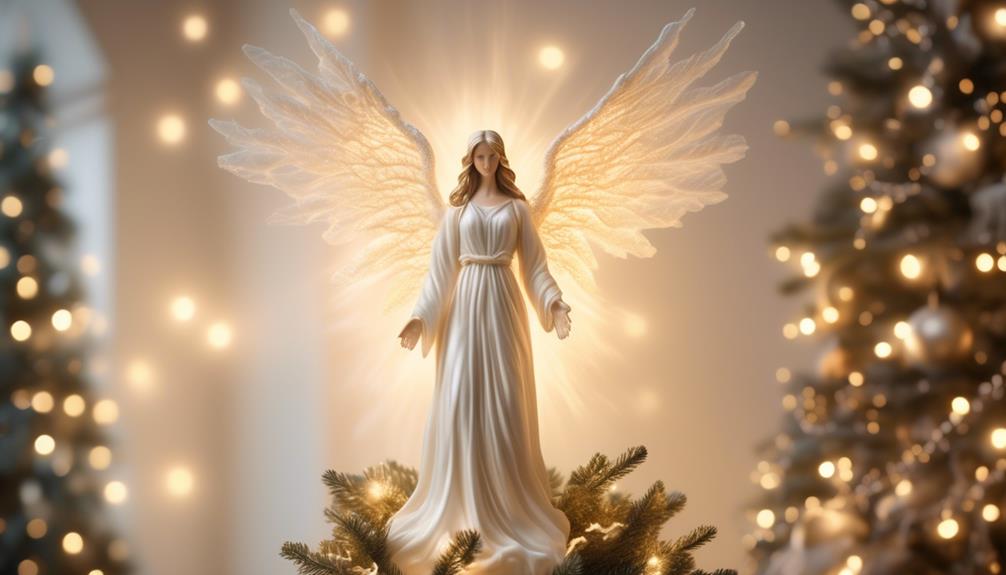
As we place the angel tree-topper on our Christmas tree, we're reminded of the heavenly messengers who bring comfort and joy during the holiday season. These heavenly beings, often depicted as divine guardians, hold a special place in our hearts and traditions.
Here are a few thoughts that might resonate with you:
- Personal Connections: Many of us have stories of feeling a sense of protection or guidance during difficult times, which we attribute to the presence of these celestial guardians. It's a comforting thought that we're being watched over and cared for by such benevolent beings.
- Symbolism of Hope: The image of angels has long been associated with messages of hope and love. Seeing an angel tree-topper can serve as a reminder of the positivity and light that these heavenly messengers bring into our lives.
- Expressions of Faith: For those with religious beliefs, angels hold a significant place in spiritual practices. The presence of an angel tree-topper can symbolize a connection to faith and a reminder of the spiritual significance of the holiday season.
As we gather around the Christmas tree, the angel tree-topper becomes more than just a decorative piece; it becomes a poignant symbol of love, hope, and divine protection.
Holiday Spirit
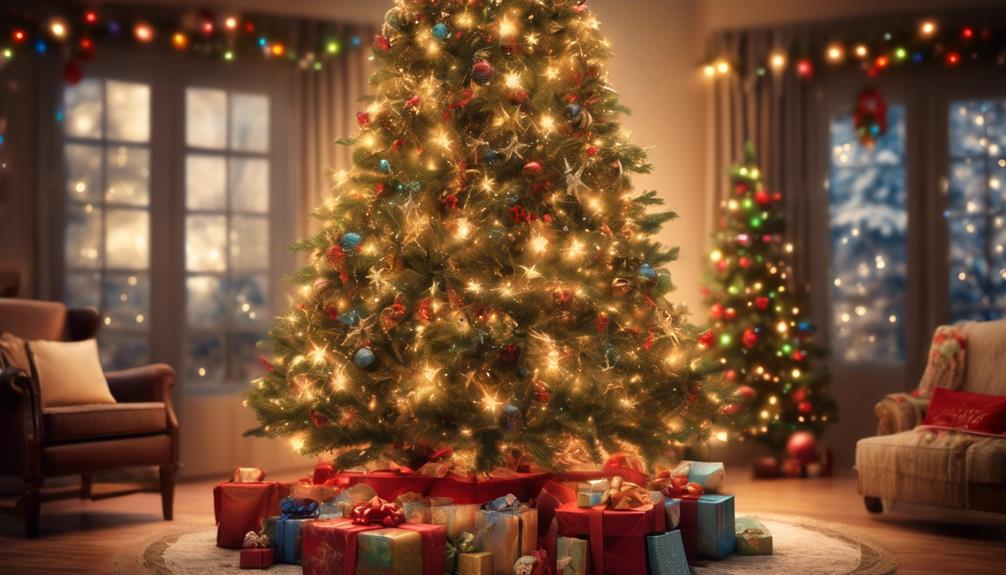
Joyfully celebrating the holiday season, we come together to share in the warmth of love and the spirit of giving. The holiday spirit fills our hearts with joy and kindness, reminding us of the importance of togetherness and the traditions that bind us.
Festive decorations adorn our homes, filling the air with a sense of wonder and merriment. As we gather around the twinkling lights and beautifully adorned trees, we embrace the holiday traditions that have been passed down through generations. From baking cookies and hanging stockings to singing carols and exchanging gifts, these traditions connect us to our past and create lasting memories for the future.
The holiday spirit also inspires us to extend a helping hand to those in need, embodying the true essence of the season. Whether it's volunteering at a local shelter or donating to a charitable cause, we find fulfillment in giving back to our communities and spreading joy to others. This spirit of generosity and compassion is a testament to the beauty of the holiday season, uniting us in a shared purpose of spreading love and goodwill.
Angel Tree Topper Placement

Let's talk about where to place the angel tree topper for maximum impact.
The symbolism of the angel and its historical significance inform the choice of placement.
We'll also explore the cultural variations in how angel tree toppers are traditionally positioned.
Symbolism of Angel
Placing the angel tree topper atop the Christmas tree symbolizes the guiding presence of angels over our homes and families during the holiday season. When we position the angel at the pinnacle of the tree, we're acknowledging the angelic presence and divine guidance that we seek in our lives.
This act holds deep significance, reflecting our belief in heavenly protection and love during this joyous time. The symbolism of the angel extends beyond religious connotations, encompassing a universal message of hope and peace for everyone.
Through the angel tree topper, we express our yearning for spiritual connection and protection, inviting a sense of serenity and positivity into our homes. It serves as a reminder of the celestial beings who watch over us, bringing comfort and reassurance during the festive season.
Historical Significance
Positioning the angel tree topper atop the Christmas tree has held historical significance as a symbol of divine guidance and protection over homes and families during the holiday season. In a historical context, the tradition of using an angel tree topper dates back to the 19th century in Germany, where it was believed to represent the angels from the Nativity story. This artistic representation was a way to visually remind families of the spiritual significance of Christmas. The angel tree topper served as a symbol of hope, peace, and goodwill, embodying the essence of the holiday season. Below is a table highlighting the historical significance of the angel tree topper in various cultures:
| Culture | Historical Significance | Artistic Representation |
|---|---|---|
| German | Symbol of angels from the Nativity story | Divine and celestial |
| American | Representation of hope, peace, and goodwill | Graceful and serene |
| Scandinavian | Significance of spiritual protection during Christmas | Ethereal and serene |
Cultural Variations
In various cultures, the placement of the angel tree topper signifies unique customs and traditions associated with the holiday season. Cultural interpretations of the angel tree topper placement vary widely, reflecting regional variations and historical influences. Here are some fascinating insights into the diverse ways this tradition is observed:
- European Influence:
- In many European countries, the angel tree topper is positioned at the very top of the tree, symbolizing protection and blessings for the household.
- Latin American Customs:
- In Latin American cultures, the angel tree topper is often placed at eye level or even lower, emphasizing the idea of the angel being closer to the family and children.
- Asian Traditions:
- Some Asian cultures position the angel tree topper at the base of the tree, signifying a grounding of spiritual beliefs within the family.
These cultural nuances demonstrate the rich tapestry of traditions surrounding the angel tree topper.
Modern Interpretations

In modern interpretations of the angel tree-topper tradition, many families have shifted towards personalizing the angel's appearance to reflect their diverse cultural backgrounds and individual tastes.
Contemporary styles have seen a departure from the traditional angelic figure clad in a flowing white gown and golden halo. Instead, families are embracing the opportunity to select tree-toppers that resonate with their unique heritage and aesthetics.
This has led to a beautiful array of angels representing various ethnicities, adorned in attire that pays homage to different cultural traditions. Some may opt for angels in vibrant, modern attire, while others may choose a more minimalist and sleek design reflective of their contemporary tastes.
The modern interpretation of the angel tree-topper has become a way for families to celebrate their diversity and express their individuality during the holiday season. It's a delightful shift that adds a meaningful touch to the tradition, allowing each family to infuse their Christmas decor with their own personal story and style.
Personal Reflections

Embracing the diversity of angel tree-toppers has allowed our family to incorporate personal reflections of our cultural heritage and individual tastes into our holiday traditions.
- Connecting with our Roots: For us, the angel tree-topper represents a way to stay connected with our cultural roots. We've chosen tree-toppers that reflect our family's diverse background, reminding us of our ancestors and the values they passed down to us.
- Honoring Holiday Memories: Each angel tree-topper we choose holds a special significance, often tied to cherished holiday memories. Whether it's a vintage angel passed down through generations or a new one representing a milestone, each serves as a reminder of the joy and love experienced during past holiday seasons.
- Expressing Individuality: Selecting an angel tree-topper is a personal experience for each family member. It's an opportunity to express our individuality and unique tastes, allowing everyone to contribute a piece of themselves to our holiday décor. This shared experience strengthens our bond and creates new memories to cherish.
Incorporating these personal reflections into our holiday traditions adds depth and meaning to our celebrations, fostering a sense of unity and belonging.
Frequently Asked Questions
Where Can I Find the Best Deals on Angel Tree Toppers?
We always look for the best prices when shopping for angel tree toppers.
Online retailers often offer great holiday discounts, but don't forget to check local stores too.
Comparison shopping helps us find the perfect topper at the best price.
It's exciting to hunt for the best deals and make our tree sparkle!
Are There Any Superstitions or Beliefs Surrounding the Placement of an Angel Tree Topper?
Superstitions and cultural significance surround the angel tree topper. Many believe it represents protection and guidance.
Historical origins date back to Victorian times, symbolizing peace and goodwill.
In Christian traditions, angels are messengers of God, signifying hope and faith.
Placing the angel atop the tree is believed to bless the household.
What Are Some Unique Ways to Incorporate an Angel Tree Topper Into My Holiday Decor?
We love incorporating angels into our holiday decor!
One unique way to showcase an angel tree topper is by using it as the centerpiece of a themed tree.
Get creative with different styles and materials for the topper, like a DIY angel made from feathers or a vintage porcelain one.
You can also add smaller angel ornaments throughout the tree to create a cohesive angelic theme.
Are There Any Specific Angel Tree Topper Styles That Are Considered More Traditional or Popular?
Traditional styles and popular designs for angel tree toppers vary widely. DIY options allow for unique decor ideas, and online deals can help find the perfect one.
Some people believe in superstitions and have specific beliefs about the angel tree topper. It's fascinating to see how different cultures and families incorporate this iconic symbol into their holiday traditions.
How Can I Make My Own Angel Tree Topper at Home?
Sure, making your own angel tree topper at home can be a fun and creative DIY project.
There are endless creative alternatives to explore, from using paper and fabric to crafting with wire and beads.
It's like designing a miniature couture outfit for your tree!
Get crafty, experiment with different materials, and let your imagination soar to create a unique homemade angel tree topper that reflects your personal style and creativity.
Conclusion
In conclusion, the angel tree topper holds deep historical, religious, and cultural significance, representing the holiday spirit and angelic symbolism.
For example, when my grandmother passed away, we placed her favorite angel tree topper on our Christmas tree as a way to honor her memory and feel her presence during the holidays. It brought us comfort and a sense of connection, reminding us of the love and joy she always brought to our family.
- About the Author
- Latest Posts
Introducing Ron, the home decor aficionado at ByRetreat, whose passion for creating beautiful and inviting spaces is at the heart of his work. With his deep knowledge of home decor and his innate sense of style, Ron brings a wealth of expertise and a keen eye for detail to the ByRetreat team.
Ron’s love for home decor goes beyond aesthetics; he understands that our surroundings play a significant role in our overall well-being and productivity. With this in mind, Ron is dedicated to transforming remote workspaces into havens of comfort, functionality, and beauty.
-

 Vetted4 weeks ago
Vetted4 weeks ago15 Best Contact Paper for Kitchen Cabinets to Elevate Your Home Decor
-

 Vetted2 weeks ago
Vetted2 weeks ago15 Best Poe Cameras for Home Security – Reviews & Buying Guide
-

 Vetted4 weeks ago
Vetted4 weeks ago15 Best Drain Snakes to Unclog Your Pipes Like a Pro
-

 Beginners Guides6 days ago
Beginners Guides6 days agoI Inhaled Vinegar Fumes
-

 Vetted4 weeks ago
Vetted4 weeks ago14 Best Stationery Brands for Your Next Writing Adventure
-

 Beginners Guides2 weeks ago
Beginners Guides2 weeks agoSwinger Porch Light Color
-

 Mardi Gras Decoration4 weeks ago
Mardi Gras Decoration4 weeks agoWhy Does Hobby Lobby Not Do Mardi Gras?
-

 Vetted2 weeks ago
Vetted2 weeks ago15 Best Blinds for Bathroom Windows to Enhance Privacy and Style

























